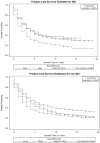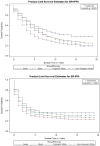Racial/ethnic differences in breast cancer survival by inflammatory status and hormonal receptor status: an analysis of the Surveillance, Epidemiology, and End Results data
- PMID: 24839049
- PMCID: PMC5729913
- DOI: 10.1007/s10552-014-0395-1
Racial/ethnic differences in breast cancer survival by inflammatory status and hormonal receptor status: an analysis of the Surveillance, Epidemiology, and End Results data
Abstract
Background: Compared to non-inflammatory breast cancer (non-IBC), inflammatory breast cancer (IBC) has less favorable survival and is more likely to be estrogen receptor (ER) and progesterone receptor (PR) negative. ER-/PR- tumors, regardless of histology, have less favorable survival. While black women are more likely to have IBC and ER-/PR- tumors than white women, it is unclear whether the racial disparity in survival is explained by these factors. The objective of this study was to assess racial/ethnic differences in breast cancer survival by inflammatory status and hormone receptor status.
Methods: This study examined breast cancer mortality among non-Hispanic white (NHW), Hispanic white, black, and Asian/Pacific Islander (API) women diagnosed between 1990 and 2004 using the National Cancer Institute's Surveillance, Epidemiology, and End Results data. Kaplan-Meier survival curves and Cox proportional hazard ratios (HRs) assessed the relationship between race/ethnicity and survival.
Results: Black women had significantly poorer survival than NHW women regardless of inflammatory status and hormone receptor status. Compared to NHWs, the HRs for black women were 1.32 (95 % confidence interval (CI) 1.21-1.44), 1.43 (95 % CI 1.20-1.69), and 1.30 (95 % CI 1.16-1.47) for IBC, IBC with ER+/PR+, and with ER-/PR-, respectively. Similar HRs were found for non-IBC, non-IBC with ER+/PR-, and non-IBC with ER-/PR-. API women had significantly better survival than NHW women regardless of inflammatory status and hormone receptor status.
Conclusion: Compared to NHW women, black women had poorer survival regardless of inflammatory status and hormone receptor status and API women had better survival. These results suggest that factors other than inflammatory status and hormone receptor status may play a role in racial/ethnic disparities in breast cancer survival.
Conflict of interest statement
Figures
References
-
- Howlader N, Noone AM, Krapcho M, Garshell J, Neyman N, Altekruse SF, Kosary CL, Yu M, Ruhl J, Tatalovich Z, Cho H, Mariotto A, Lewis DR, Chen HS, Feuer EJ, Cronin KA, editors. SEER Cancer Statistics Review. National Cancer Institute; Bethesda, MD: 1975–2010.
-
- Dawood S, Ueno NT, Valero V, et al. Differences in survival among women with stage III inflammatory and noninflammatory locally advanced breast cancer appear early: a large population-based study. Cancer. 2011;117:1819–26. - PubMed
-
- Yang R, Cheung MC, Hurley J, et al. A comprehensive evaluation of outcomes for inflammatory breast cancer. Breast Cancer Res Treat. 2009;117:631–41. - PubMed
-
- Grann VR, Troxel AB, Zojwalla NJ, Jacobson JS, Hershman D, Neugut AI. Hormone receptor status and survival in a population-based cohort of patients with breast carcinoma. Cancer. 2005;103:2241–51. - PubMed
Publication types
MeSH terms
Substances
Grants and funding
LinkOut - more resources
Full Text Sources
Other Literature Sources
Medical
Research Materials



